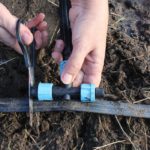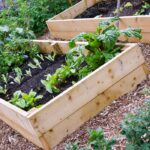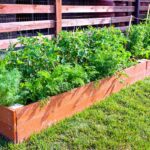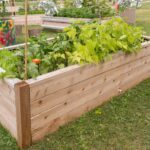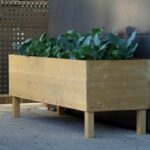Installing a trellis in a raised garden bed is one of the best methods of maximizing crop production. A trellis can help maximize the space in your garden bed by allowing vining plants like beans and cucumbers to grow vertically. But how exactly do you install a trellis in a raised bed?
To install a trellis in a raised garden bed, assemble the trellis and the fence frame and then attach the top and bottom rail. Cut and attach hog panels and attach them to the raised bed. Install your trellis before planting, and place it on the north side of the bed so that it doesn’t block light.
Let’s take a closer look at the purpose of a trellis, the advantages you can get from using it, and the plants you can grow on it. We’ll also consider the different kinds of trellises you can choose from and how you can properly install one in a raised garden bed.
What Is the Purpose of a Trellis?

The primary purpose of a trellis is to maximize space, especially if you’re working with a small area like a raised bed in an urban garden.
With a trellis in place, you’re not limited to the raised bed’s horizontal space. Instead, your plants can grow vertically. As a result, you can grow more fruits and vegetables, and your garden will also look more aesthetically pleasing.
You can use a trellis to grow most vining plants like tomatoes, peas, and beans, leaving most of the garden bed free for other vegetables. Some plants that usually grow on the ground but are also great climbers — like pumpkins, winter squash, and cucumbers — can also be grown on a trellis.
Other plants like raspberries and peppers don’t climb, but they grow better with support, so you can use a trellis in this case, too. Trellis gardening also makes harvesting relatively easier. Since it’ll keep most of your produce at a higher level, you won’t need to bend over or kneel too much.
Advantages of a Trellis
There are many benefits of using a trellis. But perhaps the biggest benefit is that you can use them with all kinds of raised garden beds, regardless of what they’re made from.
Using a trellis also reduces diseases by helping the foliage dry faster after rain and improving the flow of air around plants. Plus, by keeping plants off the ground, it’s easier to keep an eye on them to look for pests like aphids or beetles.
Which Plants Grow Best on a Trellis?
You can grow any vertical-growing plants on a trellis. Certain plants like cucumbers, peas, and pole beans can climb trellises by twining around the support. Meanwhile, other plants such as indeterminate tomatoes don’t naturally climb, but you can tie them to the trellis nonetheless.
When choosing vegetables to grow on your trellis, make sure you check that they’re appropriate for a trellis. The plant should be vining and shouldn’t be a bush variety. Let’s take a closer look at the plants you can grow on a trellis.
Indeterminate Tomatoes

Vining or indeterminate tomatoes (on Amazon) grow up to 7 feet tall and continue to produce fruit over a long time. Just make sure you tie the fresh growth of the tomatoes to the trellis every week or so with garden twine.
Cucumbers
Cucumber is the ideal plant to go on a trellis since it can take quite a bit of garden space. But make sure you choose vining varieties like Lisboa, Suyo Long, and Lemon. These cover the trellis quickly and promise crispy, juicy cucumbers.
Pole Beans
Emerite and other pole beans aren’t just delicious, but they’re also productive and vigorous. You can grow different varieties on your trellises without a problem.
Pumpkins & Squash
Just like cucumbers, squash and pumpkins can be either vining or bush. For a trellis, you need to go for a vining variety like Baby Boo pumpkins (on Amazon), Cucuzzi Italian squash, or Zucchetta Trombolina zucchini.
If the fruit is very large, the plant might need extra support. In that case, you can add slings and attach them to the trellis to accommodate the growing fruits’ weight.
Peas
You can grow different kinds of peas on a trellis, especially those that grow tall like sugar snap peas. You can choose from snow, shell, and snap types, but in general, most peas can benefit from trellises.
Melons
You can also grow small-fruited muskmelons (like Carosello melons) and watermelons on trellises. Just like with squash and pumpkins, you should add slings to support the weight of the melons.
Different Trellis Types (and How to Choose)
The kind of trellis you can add to your raised bed largely depends on the kind of bed you have. For instance, it’s quite difficult to install a permanent trellis on a raised bed made of galvanized metal compared to installing it on a wooden raised bed.
Another factor you should consider when choosing the type of trellis is the kind of vegetables you want to grow. Something lightweight like a wire A-frame trellis (on Amazon) is good enough for cucamelons and pole beans, but it won’t be able to handle the weight of melon and squash wines.
And if you’re sure that you’re going to use your trellis to grow various vertical vegetables, then you should get a strong structure. Let’s go over some of the most commonly used trellis types
Rectangular Trellis
A rectangular trellis is one of the most famous designs, and rightfully so. The long frame spans across one side of the garden bed and cattle fencing or chicken wire is secured across it, which provides good support for the plant.
However, since it blocks one whole side of the bed, you can’t reach the soil. Still, if you have a big bed, you can put the trellis across the center, so that the outside edges are free.
Covered Trellis
A covered trellis is basically a string or chicken wire attached across the center of the raised bed cover.
Archway Trellis
As the name suggests, an archway trellis (on Amazon) involves wire fencing bent in an arch. You can build this arch either between two beds or across the whole bed. If you’re looking to revamp your garden, you can even make a tunnel of vining plants that stretch several feet long.
An arched trellis provides both horizontal and vertical space.
How to Install a Trellis in a Raised Garden Bed

Installing a trellis in a raised bed isn’t too tricky. Here’s what you need to do:
- Cut the Top Rail: Take a 2”x4” 5-foot long board. Along the 2-inch side, measure ½ inch and cut a 45-degree angle at the ends to chamfer. The purpose of this angled cut is to provide a more finished look to the trellis’ top rail.
- Cut the Trellis Frame: Take 2”x2” lumber and cut four 66-inch pieces and 32-inch pieces for the frame. Fencing will be attached to this frame to make the trellis.
- Attach the Fence Frame to the Trellis: Attach the 2”x2” 66-inch board to the 2”x4” 7-foot board using finishing nails. Make sure it’s right at the center of one end of the board. Do the same for the other 66-inch board. During this step, make sure you work on a flat, stable surface.
- Assemble the Trellis: Now lay down all the pieces of the frame fence and trellis together. Make sure all the pieces will fit well together and that all the corners are square. The unattached sides of the 2”x2” 44-inch fence frame should meet right in the middle of the trellis.
A 6-foot board used for the raised bed will serve as the bottom rail. - Attach the Top Rail: Put the top rail in the middle of the frame such that the chamfered ends hang over the trellis’ sides. Make sure they overhang evenly at all ends. Once again, make sure the corners are square, and then attach the top rail to the sides of the trellis with deck screws.
- Attach the Bottom Rail: Now that you have the fence frames inserted, attach the sides of the trellis to the 6-foot bottom rail. You’ll need a couple of 4.5-inch lag screws for this.
- Attach the Fence Frames: Now attach the fence frame to the trellis using 3-inch screws. Also, attach the bottom and top rails with finishing screws.
- Cut Panels for Hog Fence: Measure two 66-inch lengths of the hog fence and cut them using bolt cutters. While hog fencing is sturdy and inexpensive, you can also use nylon netting or some other material that you prefer.
- Attach the Fence Panels: Put the fence panels you cut into the frame and then secure them on all sides using coaxial cable clips like these from Steren (on Amazon).
- Attach the Trellis to the Garden Bed: All that’s now left to do is slide the trellis over the raised bed’s ends. Make sure you do this on a level surface.
With the trellis base on the ground, use a level to ensure all sides are even. Then attach the trellis to the raised bed using three 4.5-inch lag screws on every side.
When and Where to Install a Trellis in a Garden Bed
Ideally, you should install the trellis to the raised bed before planting. Installing it while the plants are growing will be tough and can damage the roots and foliage.
If you’re making a permanent raised garden bed with a trellis, you need to consider light exposure. If you install the trellis along the south side of the raised bed, both the trellis and the crops will block light from other crops growing in the bed.
That’s why it’s better if you put the trellis along the north side such that it runs from east to west. Similarly, a temporary trellis should also be installed on the north side so that it doesn’t block the light from reaching the other plants.


